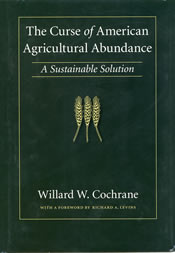Problems of Plenty:
The American Farmer in the Twentieth Century
By R. Douglas Hurt
Ivan R. Dee
192 pages
The Curse of American Agricultural Abundance:
A Sustainable Solution
By Willard W. Cochrane
University of Nebraska Press
154 pages
Children of the Western Plains:
The Nineteenth-Century Experience
By Marilyn Irvin Holt
Ivan R. Dee
224 pages
Late last year an editorial in the Minneapolis Star Tribune intoned: "Leaders from throughout the rural Great Plains should come together in a united appeal for a national effort to repopulate and reinvigorate their region. They should seek allies among the crowded coastal states, and they dare not tarry. If they do, in another generation there may be little left in the nation's midsection to revive."*
Such a repopulation program wouldn't necessarily be out of line—practically every other type of rural program has been tried over the years to aid farmers and to revive the flagging Plains. The idea of saving something, be it the family farm, small towns or some nebulous rural lifestyle, has been the motivation for much legislative handwringing in recent decades. And how's this for ironic codependency? On one side of the relationship we have the federal government, and on the other we have a collection of agrarian entrepreneurs who are the spiritual heirs of Jeffersonian anti-federalism. Indeed, the story of agriculture in the United States over the past century is a story of many things, according to R. Douglas Hurt in Problems of Plenty—things like demography, technology, political radicalism and fierce individual determination-but those are just sidebars to the real story: "Above all, however, American agriculture in the twentieth century is the story of farmers' dependency on the federal government."
 Hurt has written a concise history of U.S. farming over the past 100 years that never strays from this theme. Indeed, his book is chiefly concerned with farmers who participated in government-control pro- grams, or those dedicated to staple crops that could be stored for a long time (fruits and vegetables don't apply, for example). From the programs of the Progressive Era of the early 20th century, meant to address farmers' concerns about powerful organized interests, to the Farm Security and Rural Investment Act of 2002, which promises billions of dollars for production control programs that mimic the Agricultural
Hurt has written a concise history of U.S. farming over the past 100 years that never strays from this theme. Indeed, his book is chiefly concerned with farmers who participated in government-control pro- grams, or those dedicated to staple crops that could be stored for a long time (fruits and vegetables don't apply, for example). From the programs of the Progressive Era of the early 20th century, meant to address farmers' concerns about powerful organized interests, to the Farm Security and Rural Investment Act of 2002, which promises billions of dollars for production control programs that mimic the Agricultural
Adjustment Act of 1938, Hurt describes the efforts to craft new programs meant to ensure the survival of certain farmers.
The problem? Farmers were just too good at their job. As the title of Hurt's book suggests (as does our second book), the laws of supply and demand have had more to do with farmers' struggles over the years than rail barons and drought. Since there is a limited amount of food that a given population can eat at a certain time, the overproduction of food supplies relative to demand can only mean one thing—low prices.
What has the government done over the years to battle this fundamental law of economics? It has set prices, curtailed production or, perhaps most quixotically, tinkered with demand (for example, via food stamps, international food relief efforts and expanded school lunch programs) or some combination thereof.
And what have farmers done over the years to counter low prices? They've produced even more, of course. And rationally so. For example: When the government told farmers in 1982 that they had to reduce their total acreage if they wanted to qualify for price supports, farmers took their worst-performing acres out of production and, aided by the modern miracle of applied chemistry, got even more production out of their best-performing acres (the same thing they had done 20 years earlier under a similar program). Government-owned surpluses swelled.
Problems of Plenty is a chronological catalogue of such events, and Hurt—the director of the graduate program in agricultural history and rural studies at Iowa State University—does a nice job of weaving these programs and their consequences together while also describing other agricultural phenomena, like the increasing size of farms, rural political organization and the role of the U.S. Department of Agriculture. This is a useful book for students and interested lay readers, alike.
One thing Hurt doesn't do is suggest alternative programs or offer any other type of solution to the problem of plenty—that's not his intent; he's out to describe the problem. One man who has never shied from offering solutions, though, is Willard W. Cochrane, the author of The Curse of American Agricultural Abundance and the former chief agricultural economist in the Kennedy Administration, as well as a noted academic (many of those years at the University of Minnesota).
Cochrane has written a curious manifesto for U.S. farm policy; curious in that it includes reprints of mid-20th century speeches and essays that recall failed programs and big ideas that never came to pass, and a manifesto because he indeed lays out a solution to the U.S. farm problem, as he sees it. Although a review of previous speeches and position papers certainly sheds light on current policy, reprints on similar themes can result in redundancies and can suggest conflicts in ideas over time. Cochrane recognizes this, though, and offers an introduction to each chapter that helps to motivate it and link it to his essential thematic question: what to do about the "curse of too much production."
 One thing's for sure, Cochrane is not afraid of big ideas (he suggested nearly 50 years ago that staple crop agriculture would be largely obsolete by now because factories would produce all the carbohydrates we need through artificial photosynthesis). And he doesn't hesitate to apply the term vision to his latest plan to address the problem of agricultural overproduction and save the family farm (which Cochrane defines as one in which "the family makes all the important operating and investment decisions, owns a significant portion of the assets, and provides a significant amount of the labor required").
One thing's for sure, Cochrane is not afraid of big ideas (he suggested nearly 50 years ago that staple crop agriculture would be largely obsolete by now because factories would produce all the carbohydrates we need through artificial photosynthesis). And he doesn't hesitate to apply the term vision to his latest plan to address the problem of agricultural overproduction and save the family farm (which Cochrane defines as one in which "the family makes all the important operating and investment decisions, owns a significant portion of the assets, and provides a significant amount of the labor required").
Cochrane's big idea is based on another much-used and often misunderstood term, sustainable agriculture, which he generally describes as meeting the needs of the present while ensuring equal or better opportunities for the future. Pretty hard to hang a policy hat on that one (and isn't that the well-intentioned goal of most human activity?), so Cochrane provides a three-step working definition that would form the basis of a new national farm program to replace the provisions of the Federal Agriculture Improvement and Reform Act of 1996, which was meant to wean farmers from government dependence:
- A sustainable farmer would use farm-produced or locally available production materials rather than those produced outside the area.
- A sustainable farmer would use "positive" practices that diversify farm operations and provide alternatives to synthetic fertilizer and chemical use (like substituting animal manure for synthetic fertilizers).
- A sustainable farmer would be committed to local production inputs and enterprise diversity, not because it may prove useful at certain times and under certain market conditions, but because he is committed to a new set of values.
The three-legged stool of this new program—meant for the high-productive acreage in the nation's Corn Belt—would consist of ecological soundness, economic viability and social responsibility. We need to move to an agriculture that has the capacity to provide farmers "with an acceptable standard of living, to protect and improve the quality of resources on participating farms, to put an end to the degradation of the environment beyond the farm gate, and to end the greater farm community's dependence on continuous farm subsidies," Cochrane writes.
Of course, government programs still factor into Cochrane's plan—he suggests that the government use "Green payments" to induce farmers to undertake voluntary sustainable methods; conversely, for those farmers who refuse to participate, transition payments and loan deficiency payments under programs in existence in 2001 would be dropped. Also, since most American farmers "do not have the foggiest notion" of sustainable agriculture, the government would first embark on a large-scale education effort, consisting of "meeting after meeting," akin to the Agricultural Adjustment Administration programs of 1933-34, and on a scale that Cochrane accurately terms "demanding."
Sound idealistic? Then listen to what Cochrane has to say about the Great Plains. Here the author sides with the infamous Frank and Deborah Popper, the academic couple from Rutgers who said in 1987 that vast tracts of the Great Plains should be converted into a fenceless Buffalo Commons. Some tenets of Cochrane's Great Plains plan include the abolishment of all cash crop subsidies within one year, a voluntary farm buyout program and—in contrast to the Star Tribune's editors—a relocation program for farmers and residents of rural towns to leave the Great Plains and move to more productive areas.
Of course, this brief description doesn't do justice to Cochrane's ideas, and policy wonks, students and anyone interested in U.S. agricultural history will benefit from a reading of this far-sighted tract.
One thing mostly missing, though, from both Cochrane's and Hurt's books are anecdotes and narratives about the individual lives of the farmers they describe—and that's fine, because both books have different agendas and fill them well. Still, it's hard to contemplate the history of U.S. agriculture and not think about those noble farm families out there on the frontier, heroically battling the forces of nature, monopolies and the government in order to put cheap food on the table. OK, so there's a certain element of myth in that description, but it's a myth grounded in some pretty good stories, many of them captured in Marilyn Irvin Holt's Children of the Western Plains: The Nineteenth Century Experience.
 As the title suggests, this book—which inaugurates a new series of child-centric histories from the publisher, Ivan R. Dee—tells the story of rural life on the 19th century Great Plains from the view of its children. This book would be a real eye-opener for city kids of today, especially because many of the conditions and events described in these stories—from life in sod houses without electricity or running water, to collecting dried cow pies for fuel and toiling in the fields under conditions that would weaken the knees of a modern-day OSHA inspector—existed well into the 20th century.
As the title suggests, this book—which inaugurates a new series of child-centric histories from the publisher, Ivan R. Dee—tells the story of rural life on the 19th century Great Plains from the view of its children. This book would be a real eye-opener for city kids of today, especially because many of the conditions and events described in these stories—from life in sod houses without electricity or running water, to collecting dried cow pies for fuel and toiling in the fields under conditions that would weaken the knees of a modern-day OSHA inspector—existed well into the 20th century.
(I know, because my parents had similar experiences, and my siblings and I were often reminded of how good we had it.) The numerous black-and-white photos in this book are themselves educational.
"At times the labor of children exceeded the bounds of what was considered appropriate by that element of white middle-class America that attempted to set the tone for all society," Holt writes. "Youngsters sometimes worked at chores that were too heavy or demanding for their age, and there is no question that work-related accidents and deaths occurred."
Domestic chores brought equal strain to some children, as young girls were often relied upon to serve as homemakers, cooks and child-care providers for their mothers who were otherwise too busy with other chores, ill or deceased. For example, when Lettie Little's mother was sick for a long time after giving birth, the 8-year-old and her 10-year-old sister, Nellie, had to run the house. Lettie wrote: "That winter we matured. ... Dolls were laid aside. ... I'll confess it hurt sometimes, but if Nellie could do it I could too."
But Holt's book is no downer. Indeed, it casts a largely positive spin on those old days and recalls not just the working life of children, but their play, social connections, education and other elements that made up the rugged, but rich, experience of kids during the early years of Great Plains settlement.
This type of cultural history provides a useful balance to the statistics and plans of academics and policy officials, and reminds us that people made choices then for the same reasons they make them now—to improve their lot in life. Settlers came and went like the wind on the prairie, and while some loved the land and built great futures for themselves and their family, others couldn't wait to get out and still others would move, at the drop of a hat, as a matter of business.
Yes, there are folks today who have an affinity to farm life and rural towns who wish they could turn back the clock or, at least, keep it from moving forward. But there are a great many more who have already voted with their feet and who wouldn't move back under any circumstances. Even though I grew up as a "city boy" (in a capital city, no less, Bismarck, N.D.), I still had many connections to rural life and knew many kids who couldn't wait to get off the farm or out of tiny towns.
This is not a recent phenomenon. For most of U.S. history, agriculture has been labor intensive and children's cultural, social and educational options have been limited. My father, the youngest boy in his family, was not allowed to go to high school because he had to work on the farm. Neither he nor any of his 11 siblings ever went to college. (To his credit, though, he later opened a successful light manufacturing company and can out-read anybody I know, except my mother). Speaking of whom, my mother lived in a sod house until she was 10, and she couldn't wait to leave the farm and the never-ending chores that made up her life. Both my mother and father grew up without electricity or indoor plumbing. They can wax as nostalgic as any misty-eyed city slicker about the glory days of rural Americana, but it's nostalgia seasoned with wry reality and a fair amount of good riddance. The good old days, they are fond of saying, are right now. And theirs is not a unique story.
You couldn't dream up a government program that would lure my parents back to the land, because the only way to repopulate the land and those quaint little towns that dot the Great Plains is to turn back the clock, and that's tricky business. Speaking of cute little towns—the nearest town to my Grandpa Fettig's homestead was Burnstead, N.D., a proud little community that once boasted its own K-12 school system, three grocers, two hotels and a movie house. Today, all that remains of Burnstead are two houses on opposite sides of a two-lane rural road—the rest of the town is plowed under. For every little village out on the Plains that so many are so desperately trying to save, there are many more that are already gone. Does it matter? That's the question.
So maybe Cochrane is right, maybe it's time to give up on the Great Plains and make one last-gasp attempt that will finally "save" the family farm in the nation's Corn Belt. But Hurt's litany of failed government attempts should give pause, and Holt's stories are reminders that farmers and rural folk aren't some unified block of Jeffersonian idealists; they're rational individuals seeking the best lives for themselves—just like everyone else.
*"Rural poverty: Time running out for revival," [Minneapolis] Star Tribune, Nov. 11, 2003, p. 14A.





